Migratory birds
Common Teal
Scientific Name : Anas crecca crecca
Common Name: Common Teal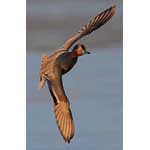
Habitat and Distribution: They found in shallow marshes with thick cover and in sheltered wetlands and coastal areas. They feed on seeds and aquatic invertebrates. It is a highly gregarious duck outside the breeding season and can form large flocks.
Migration: The Common Teal is a common and widespread duck which breeds in temperate Eurasia and migrates south in winter. Common teal are among the earliest spring migrants. They arrive on nesting areas almost as soon as the snow melts. In early February, common teal begin to depart their winter grounds, and continue through April. In central regions, they begin to arrive early in March with peak numbers in early April.
Garganey
Scientific Name : Anas querquedula
Common Name: Garganey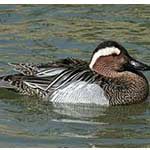
Habitat and Distribution: The species found in small, shallow ponds and lakes with abundant floating, emergent and fringing vegetation (that is not too tall or dense) grass dominated environments, like swampy meadows, flooded fields, and shallow freshwater marshes. During non breeding season the species shows a preference for large freshwater or occasionally brackish lakes, again with abundant floating, emergent and fringing vegetation, also shallow flood plains, shallow dams, pans and sewage ponds. The species also frequents coastal salt marshes and lagoons on passage and may spend the day resting on marine inshore waters when migrating.
Migration: This species is highly migratory, breeding widely across Western Eurasia and wintering within the northern tropics. It migrates on a broad front, the autumn migration beginning in late July and peaking in August or early September, with birds beginning to arrive in East and West Africa in early September, peaking in October. Once the species reaches Africa it migrates in relation to seasonal flooding, the central point of its occurrence shifting gradually along the course of rivers as the winter progresses. The spring migration begins in February, with birds beginning to arrive on breeding grounds from mid-March to early-May. It is a highly sociable and gregarious species and whilst breeding can be found in single pairs or small groups, but regularly forms large congregations of several hundred on passage, and flocks of up to several thousand are common in African and Asiatic winter quarters.
White-Eyed Pochard
Scientific Name : Aythya nyroca
Common Name: White-eyed pochard
Habitat and Distribution: The main part of the population occurs in Asia, where there is much suitable habitat and it remains common, although quantitative data are lacking. Given that this species's range may fluctuate considerably from year to year owing to changing water levels, it is unclear how much one-off high counts from Asian countries represent just one mobile population. The key threat is the loss of its wetland habitat of well vegetated shallow pools through drainage, abandonment or intensification of fishponds, development of dams and building of infrastructure on flood plains. Increased drought due to global climate changes may pose a problem to the species in part of its range. Hunting is also a serious threat and protection may not be effective either because of misidentification or because of poor law enforcement.
Migration: The wintering range overlaps with the breeding range and extends to the Middle East, north-east and West Africa and South-East Asia. Four main populations are recognized and migration occurs from early September to mid-October, whilst breeding grounds are re-occupied from mid-March to early May.
Asiatic Sparrow-Hawk
Scientific Name : Accipiter nisus
Common Name: Asiatic sparrow-Hawk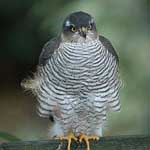
Habitat and Distribution: The species is found in forest or groves and orchards in well-wooded country. In non-breeding season it is a silent bird and does not attract attention but it is very widely scattered all over India and Burma. Its habits generally are the same as those of the next and better-known bird. Breeding North and Central Asia to Japan, in Winter South to almost the whole of India, Burma and South China. In India it occurs as far South as the Nilgiris.
Migration: This bird is only a winter migrant to India and Burma, arriving in October and leaving in March. During autumn migration sparrow hawks appear in small numbers along our coast. Ringing recoveries confirm that young sparrow hawks display a stronger migratory urge than adults.
Buzzard
Scientific Name: Buteo buteo
Common Name: Buzzard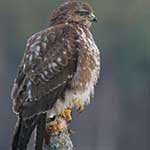
Habitat and Distribution: The buzzard, although not a native of the Eastern Counties and is a medium to large bird of prey, whose range covers most of Europe and extends into Asia. It is usually resident all the year, except in the coldest parts of its range, and in the case of one subspecies. It is the largest and most graceful bird of prey, prefers wooded hillsides, woodlands and marshes and rocky coasts.
Migration: Buzzards do not normally form flocks, but several may be seen together on migration or in good habitat. The western Buteo group is mainly resident or short-distance migrants.
Pale Harrier
Scientific Name : Circus macrourus
Common Name: Pale Harrier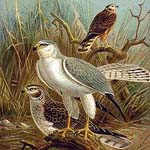
Habitat and Distribution: Circus macrourus breeds primarily in the steppes of Asiatic Russia, Kazakhstan and north-west China. Small populations breed in Indian subcontinents. Assessment of the status of this species is complicated by the fact that on breeding territories numbers fluctuate in response to environmental conditions, probably numbers of small mammals. Thus, high or low numbers in any given year or two year period may be indicative of change in demographics or they may be indicative of change in local environment.
Migration: This is a migratory bird of prey of the harrier family. It breeds in southern parts of Eastern Europe and central Asia and winters mainly in India and Southeast Asia. Reliable records from migration routes and wintering grounds are also difficult to obtain owing to the rarity of the species, its broad-front migration strategy, and difficulties in field identification, although important concentrations of birds have been identified in parts of India and Africa.
Montegu's Harrier
Scientific Name: Circus pygargus
Common Name: Montegu's Harrier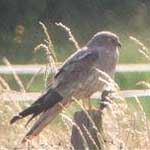
Habitat and Distribution: This species can be found in a middle-latitude band of predominantly temperate climates, but also in Mediterranean, and boreal zones. Although it has been found nesting up to 1500 m, it is essentially a lowland species, and nests mostly in broad river valleys, plains, and levels bordering lakes and the sea. It can breed in wetlands, though these are often smaller and dryer than those used by the Marsh Harrier. It also utilizes heaths, dunes, moors, and can be found in the steppe. It adapts to shrub lands in gorse or heather and to areas planted with young conifers. When no other suitable habitat is available this harrier will nest in agricultural farmlands where it is vulnerable to early harvesting. In Western Europe, up to 70 percent of the population breeds in artificial habitats.
Migration: The bird is a long distance migrant. Birds from Eurasia spend the winter in sub-Saharan Africa, while those from the eastern part of the range migrate to the Indian subcontinent. In Europe, the first birds start to move at the beginning of August and most have left by mid-October. They travel over a broad front, crossing the Mediterranean at various points, and only a small number are observed at migration choke points. Western birds don't go further south than the gulf of Guinea, but some eastern birds travel as far as South Africa. In Africa their diet is composed mostly of insects and birds, and it is possible that they follow locust swarms.
Marsh Harrier
Scientific Name: Circus aeruginosus 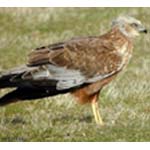
Common Name: Marsh Harrier
Habitat and Distribution: The marsh harriers are birds of prey of the harrier subfamily. They are medium-sized raptors and the largest and broadest-winged harriers. Most of them are associated with marshland and dense reed beds. The Western Marsh Harrier found in Kerala often simply called the Marsh Harrier, breeds widely across Europe and Asia. It hunts small mammals, insects and birds, surprising them as it drifts low over fields and reed beds. In the breeding season, it occurs mainly in freshwater wetlands, fishponds, and marshes, but is increasingly found also in agricultural areas.
Migration: It is migratory except in the mildest regions, and winters mainly in Africa. Birds from northern, eastern, and central Europe are complete migrants, wintering in the Mediterranean Basin and sub-Saharan Africa, although few cross the equator. Populations breeding in Asia winter south to India, Sri Lanka, Southeast Asia, and the Malay Peninsula. Birds breeding in southern Europe, the Mediterranean Basin, and the Middle East are largely sedentary. The species present in India between August and April months and arrives at roosts in the Akola District in Maharashtra by mid-October.
Osprey
Scientific Name: Pandion halietus
Common Name: Osprey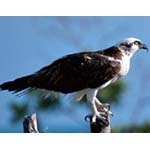
Habitat and Distribution: The Osprey tolerates a wide variety of habitats, nesting in any location near a body of water providing an adequate food supply. It is found on all continents although in South America it occurs only as a non-breeding migrant. The Osprey has a worldwide distribution and is found in temperate and tropical regions of all continents except Antarctica.
Migration: The variation of timing and duration in autumn was more variable than in spring. Although migrating predominantly in the day, they sometimes fly in the dark hours particularly in crossings over water and cover on average 260–280 km/day with a maximum of 431 km/day. European birds may also winter in South Asia, an Osprey ringed in Norway has been recovered in western India.
Pied Harrier
Scientific Name: Circus melanoleucos
Common Name: Pied Harrier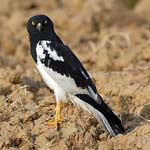
Habitat and Distribution: The population consists of approximately 10,000 individuals and the number is thought to be in moderate decline. They found in steppes and associated wetlands. Wintering individuals are often seen hunting above rice paddies and marshes.
Migration: The bird is migratory, breeding from Amur valley in eastern Russia and north-eastern China to North Korea. Wintering individuals can be found in a wide area from Pakistan to Philippines.
Peregrine Falcon
Scientific Name: Falco peregrines
Common Name: Peregrine falcon
Habitat and Distribution: The Peregrine Falcon (Falco peregrinus), also known as the Peregrine can be found nearly everywhere on Earth, except extreme polar regions, very high mountains, and most tropical rainforests; the only major ice-free landmass from which it is entirely absent is New Zealand. This fact makes it the world's most widespread bird of prey.
Migration: This is a widespread resident and winter visitor in India. Only populations that breed in Arctic climes typically migrate great distances during the northern winter.
European Kestrel
Scientific Name: Falco tinnunculus
Common Name: European kestrel
Habitat and Distribution: Falco tinnunculus is a bird of prey species found in lowlands and prefers open habitat such as fields, heaths, shrub land and marshland. It does not require woodland to be present as long as there are alternate perching and nesting sites like rocks or buildings. It will thrive in treeless steppe where there are abundant herbaceous plants and shrubs to support a population of prey animals.
Migration: In the cool-temperate parts of its range, the European Kestrel migrates south in winter; otherwise it is sedentary, though juveniles may wander around in search for a good place to settle down as they become mature. Partial migrant and there is also local post-breeding dispersal in response to rainfall changes. Northern European and Russian populations migrate to southern Europe and Africa as far south as the Gulf of Guinea. Upland birds in northern and western England tend to winter at lower elevations and more southern locations, mainly southeastern England and some juveniles disperse to mainland Europe.
Oyster Catcher
Scientific Name: Haematopus osralegus
Common Name: Oyster catcher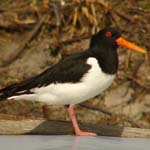
Habitat and Distribution: These are the common waders who have spread their territories in Europe from the coast to inland regions by adapting to food sources offered by meadowlands. They also found on ice land from coastal regions to more inland meadow areas and they breed in the same area. It is a very quarrelsome bird and quite aggressive towards one another during the breeding season. They also show the habit of simulating crippled wings in order to lure you away from their nests. Given suitable habitats they can be found all along the coastal regions of Iceland.
Migration: The larger part migrates to Western Europe. A small part of the population stays during the winter period. Most populations of this species are fully migratory, inland breeders moving to the coast for the winter. The species breeds from April to July in solitary pairs or small groups, during the winter foraging singly or in small groups of up to 10 individuals and with larger flocks often forming in major bays and estuaries and at roosting sites.
Eastern/Pacific Golden Plover
Scientific Name: Pluvialis fulva
Common Name: Eastern/Pacific golden plover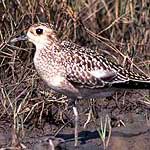
Habitat and Distribution: Pluvialis fulva found on coastal mudflats, beaches, reefs, inland on short grasslands (such as airfields) or around freshwater pools, lakes, rivers, marshes, rice fields. Their preferred foraging ground is intertidal mudflats. They are gregarious birds, migrate, feed and roost in large flocks. The Pacific Golden Plover breeds on the Arctic tundra in western Alaska. It winters in South America and islands of the Pacific Ocean to India, Indonesia and Australia. In Australia it is widespread along the coastline.
Migration: Phenomenal long-distance travellers, after breeding in the Arctic, these plovers migrate to spend winter almost half way around the world (5,000-13,000km away one-way). Some winter on tiny islands in the Pacific and Indian Oceans, a feat this requires precise navigation. Siberian breeders migrate to Africa, India, Indochina, and Southeast Asia all the way to Australia.
Large Sand Plover
Scientific Name: Charadrius leschenaultia
Common Name: Large sand plover
Habitat and Distribution:Charadrius leschenaultia is predominantly found in open, dry, treeless, uncultivated areas, including dried mud, silt and clay flats, hard salt-pans overgrown with halophytic plants and rocky plains near mountains in desert or semi-desert in breeding seasons. During the non-breeding season, this species shows a preference for littoral habitats with mixed sand and mud substrata. It is found on sheltered sandy, shelly or muddy beaches, large intertidal mudflats, sandbanks, salt-marshes, estuaries, coral reefs, rocky islands, tidal lagoons and dunes near the coast, although it may sometimes feed on coastal grasslands.
Migration: This species is fully migratory, and is likely to migrate without stopping on a broad front between breeding and non-breeding areas. Migratory flocks form after the end of breeding between mid-June and early-August, and arrive in the wintering grounds between mid-July and November (adults and immature birds arriving before juveniles). Those birds wintering in South-East Asia start moving northwards to the breeding grounds in late-February (the migration peaking in March to early-April), arriving from mid-March to May; whereas those wintering in East Africa and southern Asia depart for breeding grounds from mid-April to early-May. Most non-adult wintering birds remain in the wintering areas during the breeding season.
Source: Kerala Forests and Wild Life Department